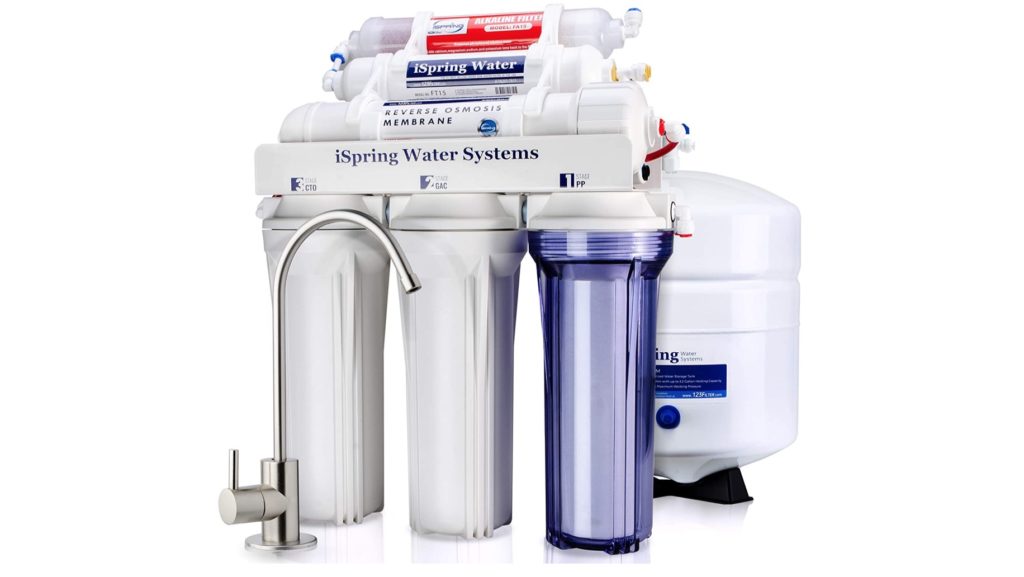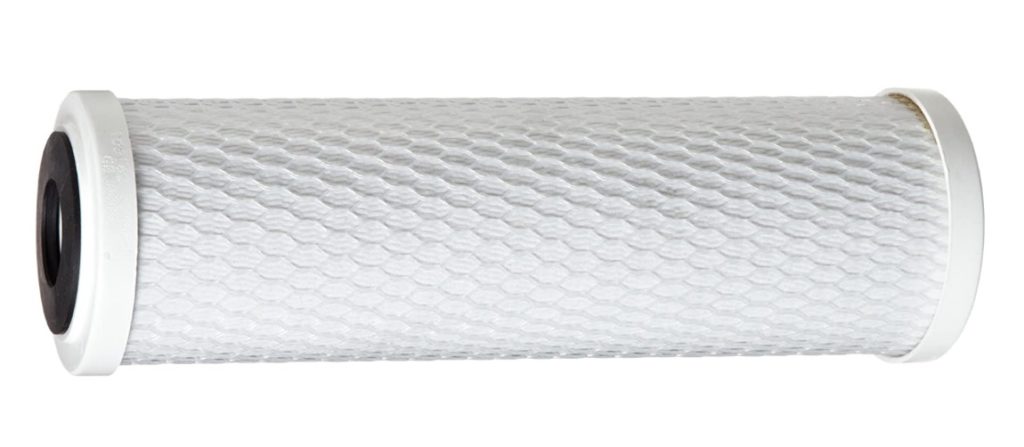Choosing a water filter isn’t as simple as you might think. That’s because there is a surprising amount of chemistry and physics (plus hydrology and biology) that goes into these devices. Most of the tough stuff can be left up to the engineers and PhDs who are designing and defining water filters, but choosing a water filter will require at least knowing the basic types of filters and figuring out which is the right one for you.
We will focus on water filtration for the home buyer, but these choices will also be applicable for small buildings, apartments, small businesses, and similar dwellings, like RVs.
This article will start by talking about types of water filtration while and will then move to types of water filters (under-the-sink, on-the-counter, faucet-mounted, etc.)
Types of Water Filtration
These are methods by which water is filtered, not necessary the types of filters you’d end up buying. Those will be discussed at the bottom of the article.
Reverse Osmosis Water Filter
As you get into your research, the first serious water filter that you will is the reverse osmosis system (RO). This type is very popular with home buyers because they are highly effective (though, remember, nothing is 100% effective) and relatively affordable.
The reverse osmosis process essentially works by using pressure to forces water molecules though a membrane. Because water is incredibly tiny, the membranes lets water through but traps contaminants on the “dirty” side of the membrane. The contaminants that are collected are flushed out of the system, so that the membrane doesn’t clog.
Example of an RO Filter: iSpring RCC7AK 6-Stage Under-Sink Drinking Water Filter System
Advantages of Reverse Osmosis
- Large contaminants, like parasites and viruses, are almost entirely removed
- No electricity is required for the system to process water, just water pressure
- Membrane filters last a long time, upwards of three years (though pre- and post-filters might have to be changed more frequently)
Disadvantages of Reverse Osmosis
- The filtration process is slow so a storage tank is required near the faucet
- Considerable waste: As little as 25% of water is cleaned in the filtration process, the rest flushes away contaminants
- If pressure is not sufficient water may not get through the membrane
- A malfunctioning/damaged membrane isn’t immediately clear to users
If you are buying a reverse-osmosis filter you will want to see that is has NSF/ANSI 58 compliance.
Activated Carbon Water Filters
Activated carbon or charcoal filters might seem like a low-tech approach to water filtration but they do get the job done. Activated carbon has been treated with oxygen to open up an incredibly huge amount of surface area within each piece of carbon — hundreds of square meters per gram! When water flows around the carbon impurities can get trapped in the nooks and crannies of the carbon. Carbon filters are most effect with carbon-based impurities like pesticides and herbicides.
This solution is sold in a number of forms, like charcoal sticks or small grains that need to be kept in some form of housing. There also “block” carbon filters that look like a normal filter.
Product Examples
- Activated Charcoal Stick: Kishu Binchotan Water Purifier Stick
- Whole House Filter: Aquaboon House House Filter Cartridge
Advantages of Activated Carbon
- Affordable
- A “natural” solution
- Most agree that it will improve the taste of water
- Requires no electricity
- No water waste
Disadvantages of Activated Carbon
- Sodium and other materials will not be trapped and will pass right through this filter, some of them are things you’d want filtered out of your water, like mercury and nitrates
- Water that flows around the carbon will not be treated
- A broken carbon pore can cause trapped contaminants to leak
- No antibacterial properties
Note: Some of these pros and cons will vary based on if you use a block carbon filter or a lower tech carbonized stick (bamboo carbon for instance).
Activated Alumina Water Filters
Activated alumina filters are composed of highly porous aluminum oxide (Al2O3), and are effective at trapping impurities like fluoride (to an extremely high degree), arsenic, and selenium.
Ceramic and Fiber Water Filters
These are mechanical water filters that hold larger debris but are not effective at trapping harmful materials like lead or mercury. They are mainly used for stopping sediment and organic materials that effect the taste/smell of water (tested with NSF/ANSI 42 certification).
A good example of this type of filter would be the black filter used on a Big Berkey water filter.
Ultraviolet (UV) Treatment
UV filters used to be exclusively limited to commercial and industrial applications, but that’s changing with time. It’s very effective at stopping anything that’s “living” like a bacteria, microorganism, or virus but won’t do anything about lead, copper, or mercury. UV mainly picks up where municipal treatment leaves off — it’s very effective at killing anything in your water that chlorine treatment at your water supply will miss — but it’s not an effective water filtration treatment on its own.
Not True Filtration: Water ionizer (Alkaline Ionizer)
Using the process of electrolysis, these filters have charged plates that separate the water into an alkaline and an acidic side. These machines produce alkaline water (water with an elevated pH balance). This filters affect the pH of water but do not generally filter the water unless the ionization is combined with another process. Alkaline water is believed to have health benefits by some people, but many others question those claims. Regardless of any health benefits, it is not an adequate filtration process.
Types of Water Filters
Now that you know how your water is being filtered, it’s time to discuss how those filters appear in your home or office. The main points in the home where water is filtered before it’s used are:
- Carafe
- Shower
- Faucet-mounted
- Under the counter
- On the counter
- Refrigerator
- Point-of-Entry (Whole home)
Each of these methods has its advantages and disadvantages, which will combine to make the most effective method for your home. For instance, people are fine with a faucet-mounted filter but you might want to opt for an under-the-counter system if you want a more powerful filtering solution that doesn’t need as much maintenance. Or you might want to upgrade to a whole home filtering system if your water has a less-then-ideal taste or smell that is affecting your showering water as well as your drinking water. Only you know the best fit for your home!
Read More: What Water Filter Improves Taste?

